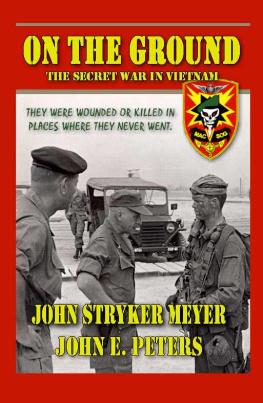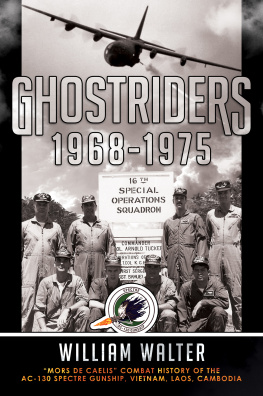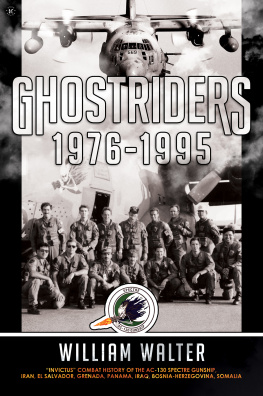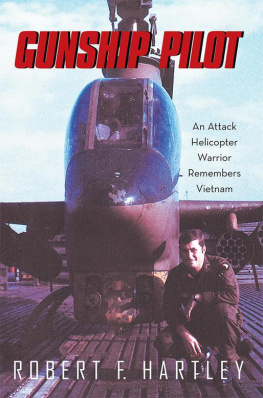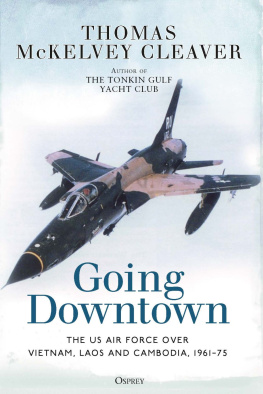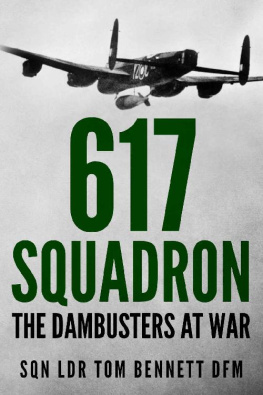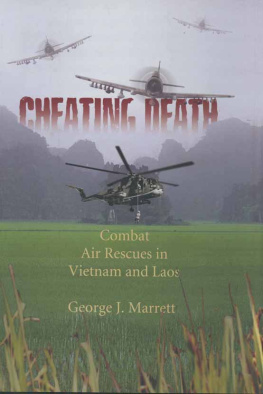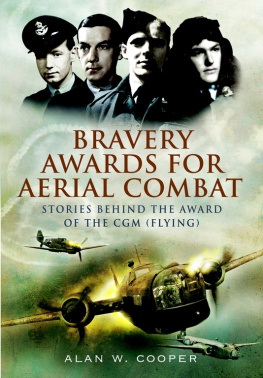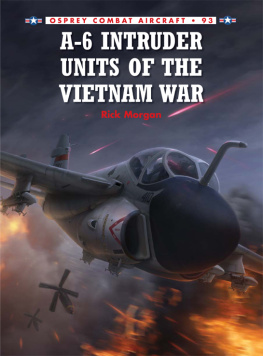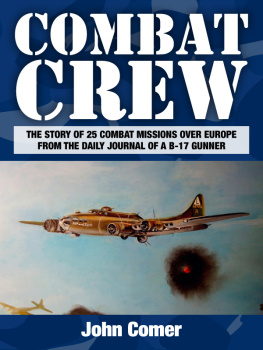SPECTRE
GUNNER
The AC-130 Gunship
MSGT. DAVID M. BURNS
iUniverse, Inc.
Bloomington
Spectre Gunner
The AC-130 Gunship
Copyright 2013 by Msgt. David M. Burns.
All rights reserved. No part of this book may be used or reproduced by any means, graphic, electronic, or mechanical, including photocopying, recording, taping, or by any information storage retrieval system without the written permission of the publisher except in the case of brief quotations embodied in critical articles and reviews.
iUniverse books may be ordered through booksellers or by contacting:
iUniverse
1663 Liberty Drive
Bloomington, IN 47403
www.iuniverse.com
1-800-Authors (1-800-288-4677)
Because of the dynamic nature of the Internet, any web addresses or links contained in this book may have changed since publication and may no longer be valid. The views expressed in this work are solely those of the author and do not necessarily reflect the views of the publisher, and the publisher hereby disclaims any responsibility for them.
Any people depicted in stock imagery provided by Thinkstock are models, and such images are being used for illustrative purposes only.
Certain stock imagery Thinkstock.
ISBN: 978-1-4759-6972-6 (sc)
ISBN: 978-1-4759-6974-0 (hc)
ISBN: 978-1-4759-6973-3 (ebk)
Library of Congress Control Number: 2013900056
iUniverse rev. date: 01/28/2013
CONTENTS
This book is dedicated to the Spectre crewmembers who lost their lives in defense of their country. Each and every one of them was a very special airman whom the nation can be very proud of. It is also dedicated to all the Spectre menpast, present, and futurewho are still living up to the standards of duty, honor, and country in their everyday lives. And to the Spectre airmen who are now involved in another war.
Special dedication to Senior Master Sergeant Brian P. Morrison, who took care of me in the worst of times and always kept his word; to Chief Master Sergeant P. J. Cook, a gunner who helped me with parts of this book; and to all the Spectre men who have passed away since the end of the Vietnam War. I love them and miss them all very much, and I look forward to seeing them again somedaybut not too soon, I hope. They actually lived the code: duty, honor, country.
AAA (Triple A): anti-aircraft artillery
ABCCC: Airborne Command and Control Center
AC: aircraft commander
ACM: additional crew member
AP: air police
ARRS: air rescue and recovery service
ARVN: Army of the Republic of Vietnam
BC: Black Crow
BDA: battle-damage assessment
Charlie: vietcong
DMZ: demilitarized zone
E&E: escape and evade
Fence: border between Thailand and Laos
fire base: army artillery base
FIS: fighter intercepter squadron
fragged: assigned to a specific area of operations
TFS: tactical fighter squadron
Gomer: NVA Vietcong, and communist troops
ground-pounder: a non-flying airman
IO: illuminator operator
IR: infrared operator
Jolly Green: air force rescue personnel flying HH-53 helicopters
LLTV: low-light-level TV
mm: millimeter
Moonbeam: nighttime call sign for ABCCC
NKP: nakhon phanom
NOD: night-observation device
Palace Gun: special air force volunteer program, aerial gunner
PJ: Para rescueman
SAM: surface-to-air missile
sparkle: firing tracers into the target so the F-4 can see where to bomb
TDY: temporary duty
TIC: troops in contact
winchester: out of ammunition
Prior to joining the US Air Force in 1967, I joined the US Navy when I was fifteen years old. I spent sixteen years in the US Navy as an aviation ordnance man (airborne weapons). My last duty station was at the US Navy Recruit Training Command in San Diego, California, where I trained new recruits for three years. In 1969, I was assigned to the Sixteenth Special Operations Squadron as an aerial gunner. After retiring in 1978, I wanted to write a book about my experiences in the squadron, but I kept putting it off. In 2012, I decided to tell the story of the most outstanding men I have ever had the privilege to know. It is a story of a select group of men who chose to fly very hazardous nightly combat missions over uncharted mountainous terrain deep in enemy territory called the Ho Chi Minh Trail. These men were shot at nightly; in six cases, they were shot down. Bravery, honor, and heartbreak were nightly occurrences.
David M. Burns
Master Sergeant, US Air Force, Retired
My story begins in December 1969. I had just completed aerial gunners school in Lockbourne, Ohio. I attended survival school at Fairchild Air Force Base in Washington and finished at the Pacific Air Forces (PACAF) Jungle Survival School in the Philippines.
I was assigned to the Sixteenth Special Operations Squadron as an aerial gunner in the Palace Gun program. I was part of a twenty-six-man replacement (both officers and enlisted) crew that was replacing squadron members who had finished their one-year tours.
I knew the first sergeant of the combat wing at Clark Air Base since I had served a previous Vietnam tour in 19671968. I had met him at the NCO club, and he asked me where I was going. I told him I was assigned to Ubon Royal Thai Air Force Base in Thailand for duty with the Sixteenth Special Operations Squadron.
He looked at me like I was crazy and said, Those birds are sitting ducks! One was just shot down this year!
I told him it was what I wanted, and he told me to contact him when I finished snake school (jungle survival). He would arrange a direct flight to Ubon from Clark since they had a daily scatback (T-37) flight going. He said I could take a friend with me if I wished. If I took the regular klong flight (a C-130 trash hauler), I would have to stay in Bangkok for a few days. The upcountry shuttle would take all day.
I told him I would let him know, and we went to town. During our training, I made two friends that I especially got along with. Jerry Olson (Oley) was a staff sergeant who was a motorcycle nut. The other was Dwight, a young airman who was just starting out in the air force. I got along with the rest of the people okay, but Oley, Dwight, and I hung out together.
The senior student was kind of a dunderhead, and I didnt get along with him at all. The day finally came when we were set to leave. We were scheduled for the klong in two days. I contacted my buddy and told him I was ready to go. I asked Oley and Dwight if they wanted to come along, but they wanted to spend a couple of days in Bangkok.
I made my arrangements with the first sergeant and was scheduled to leave the next day. I told Oley to tell the student leader when he called my name for roll call to say, I heard that Dave went AWOL with a Filipino broad. The next morning at 0730, I got on the scatback and hauled ass!
CHAPT E R ONE
The Squadron
After three hours, we arrived in Ubon Air Base. The scatback had radioed ahead and told the tower to tell the Sixteenth that they had an incoming crewmember. As I went into the small terminal I was greeted by a tall, sharp-looking technical sergeant with a marine haircut. He looked like a marine NCO. He introduced himself as Technical Sergeant Jack (his call sign was Gunner Jack) and put me in the back of a jeep.
We arrived at the squadron; the first thing I noticed when I entered the building was the emblem right above the entrance door. It was a ghost coming out of a full moon with a blue hood and two 20mm guns blazing. To the right of the front door, a sign said, Spectre: The Fabulous Four Engine Fighter! I saw Spectre on all the office doors.
I was introduced around. Everyone from officer to enlisted was very friendly and did their best to make me feel at home. I met the first sergeant, and he indoctrinated me into the squadron. He told me about the outfits history, its nightly missions, and its outstanding, all-for-one-and-one-for-all mentality. The squadrons theme song was Ghost Riders in the Sky. It did seem most appropriate.
Next page

